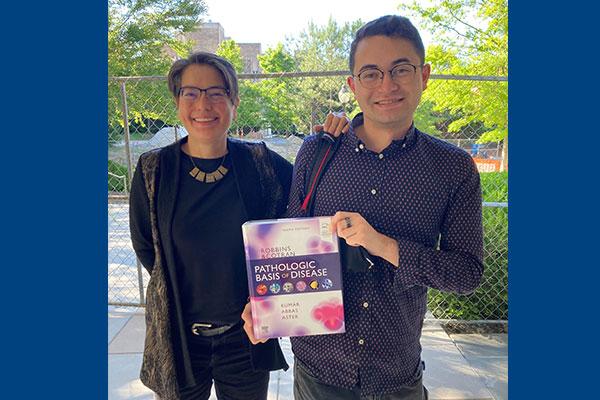
The Pathology Interest Group (PIG) sponsored an essay contest in April for first-year Duke medical and Pathologists Assistant Program students to win a copy of the “Robbins Pathologic Basis of Disease” textbook. Sully Chen won with his essay titled “How Does Understanding Pathology Help Inform and Improve Patient Care?”
In it, he discusses the roles of pathologists in healthcare and how their understanding of pathology on an individual-provider level positively contributes to patient care. He closed the essay by writing, “A deep understanding of pathology, when transferred to the patient via the caring words of a provider, yields the courage to bravely face what is known, rather than wander through the fog.”
Chen is a medical student from Los Angeles. He was previously a research scientist at OpenAI and his primary interest is the emerging role of artificial general intelligence in medicine. He is passionate about research in many fields and has published work (or has work under review) in pure mathematics, earth science, artificial intelligence, physical chemistry, sleep medicine, and neurosurgery.
*Pictured: Andrea Deyrup, MD, PhD, presenting book prize to Sully Chen
Sully's Winning Essay: How does understanding pathology help inform and improve patient care?
This question has two immediate answers in my mind: one obvious answer and one subtle/more meaningful answer. The obvious one relates to the specific role of pathologists in healthcare; pathology is the backbone of modern medicine — without labs, cultures, biopsies, etc., modern clinical practice would come to a grinding halt (though we would still have clinical intuition/skills to guide treatment). I think it’s easy to take lab orders for granted and remain blissfully unaware of the miraculous journey a blood draw, for example, embarks on after it’s drawn. I recently had the opportunity to tour the laboratories at Duke and witness the extraordinary infrastructure and technological stack that coalesces together to enable the high-throughput analysis required by the hospital. The sheer number of moving parts — and the fact that it even works — is astonishing. This understanding of pathology is hidden from most eyes, yet it’s what enables modern patient care.
The less obvious answer pertains to what an understanding of pathology on an individual-provider-level contributes to patient care. There are several layers of depth to this; on the surface, it’s obvious that providers need to have an understanding of the pathology of disease to effectively treat it. Yet, I would argue that providers need to have a substantially deeper understand of pathology to communicate to patients. As a quick example, there are treatment guidelines/prognoses associated with the grading and staging of various malignancies, and it’s definitely a process to memorize these and follow them accordingly, with the appropriate judgement calls. However, conveying to a patient their grading/staging can end up requiring considerably more nuance. Although I’m not yet a healthcare provider, I have unfortunately had friends who have themselves received diagnoses of cancer and were presented with the biopsy results by their physician. I remember on one particular occasion many years ago, a friend came to me with concern that one of her family members had been diagnosed with colorectal adenocarcinoma. Their physician had given them an explanation of the grade, stage, and prognosis of their disease, but questions still remained: “What’s the difference between grade and stage?” “How did they determine the grade of the cancer?” “Why are grade and stage separate measures?” “What do they mean by gland-forming?” I felt pretty powerless, since I hadn’t started medical school at this time, nor did I have remotely enough understanding to answer any of these questions.
In some sense, these questions aren’t really related to the prognosis of the disease or the course of treatment — they were questions that were primarily for the patient and family’s curiosity and peace of mind; understanding the disease gave more power and closure to the family than abstract notions of “low grade” or “stage 2.” In this sense, a deep understanding of pathology helps in a holistic, patient-centered approach to patient care; having enough knowledge to answer any of the patient’s questions, to inform the patient and give them the power of understanding. This idea felt especially relevant when Dr. Deyrup mentioned that many patients actually want to see their pathology slides and reports; they want to see what they’re up against, put an image to the battle, and feel the empowerment that the knowledge yields them. A deep understanding of pathology, when transferred to the patient via the caring words of a provider, yields the courage to bravely face what is known, rather than wander through the fog.